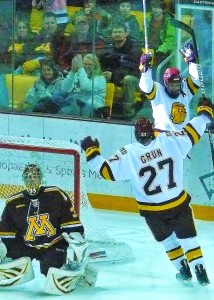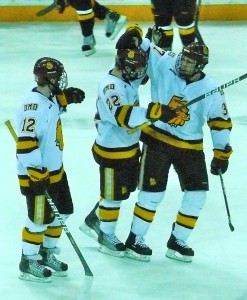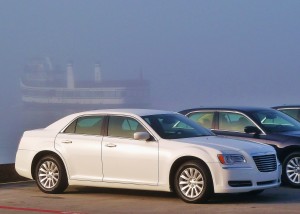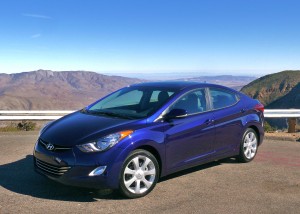Chrysler aims high, 300 hits target
By John Gilbert
There were three distinct reasons why I was ready to be impressed by the 2011 Chrysler 300.
First, when the 300 was resurrected for a reintroduction five years ago, the look was abrupt and bold, and bricklike. I’m all for abrupt and bold styling, but I am definitely not a fan of designing vehicles to resemble a brick. The Chrysler 300 turned out to be North American Car of the Year, proving that Chrysler was wise in its polarizing design, because love/hate polarity works if enough of the “love” side buys your car. Now that the Chrysler 300 is not only due for replacement, but is representing a microcosm of Chrysler corporation itself in its battle for survival, I was hoping the new 300 would improve on the outgoing brick…I mean, car.
Secondly, a number of cynics in the media seem to be ready to let Chrysler fail, after General Motors and Chrysler both required government aid to get to bankruptcy procedures that avoided going out of business. While most seem to be pulling for GM, it seems that the cynics among auto journalists have no sense of pulling for the underdog as Chrysler battles to reach sea-level.
The third reason is more self-gratifying, perhaps, but the 300’s introduction was being held in San Diego, where folks were grumbling about the January temperature dipping to something like 67 degrees. That was during a January week when the temperature in Minnesota was somewhere between 15-25 degrees below zero. I feel fully invigorated when it gets extremely cold, but this has been a winter where I’ve learned that there can be limits to necessary invigoration, and then it’s nice to get away to somewhere like…San Diego. So it would be a nicer trip if the Chrysler 300 was good, too.
The new 300 will be a worthy flagship for the rising prospects of Chrysler. It is just now making its way to dealerships, and once it shows up, consumers can climb in and around it in a setting more realistic than the Detroit or Chicago auto shows, and find out that the new car is a significant step forward — for the car, and the corporation.
Fiat is taking over Chrysler, and the merger of those corporate minds is perfectly timed. The Italian flair for design and style is notable, but Fiat officials also seem genuinely impressed with Chrysler’s history and potential in the marketplace. Chrysler designers and engineers, meanwhile, have been focused on impressing their new owners. When we met a carefully aligned group of 300s parked on a pier in San Diego’s harbor, Olivier Francois, the new president and CEO of Chrysler Brand’s segment, was about to address the assembled media members when the microphone wouldn’t work.
“We’ve put our money in the car,” Francois said, “so there is no money for microphones.”
A lively wit is a key ingredient for a successful automobile executive these days, and Francois was sharp. “We wanted to prove to the world that you don’t have to cross the ocean to get a great car from Chrysler,” Olivier said. “We think the 300 will reignite the full-size sedan segment. It’s not easy to follow the most-decorated sedan ever, but we’ve bench-marked the best sedans in the world for quality, materials, fit and finish, and performance, and we think the new 300 is not only beautiful, but it will perform.”
By setting up vehicles as the best in various categories as bench-marks, Chrysler learned its own limits and capabilities. A car that is best in some areas might be lacking in others, and while Chrysler isn’t claiming to have beaten all of them, by making the new 300 competitive with all of them in all categories makes the new 300 better than most in combining the assets into one vehicle. Read more
‘Non-goal-scorer’ Mike Connolly hits UMD record
By John Gilbert
It was one of those magical games that goal-scorers seem to have — except that Mike Connolly doesn’t consider himself a goal-scorer. The puck kept coming to him, and every time he shot, the puck seemed to go into the net. The only instance where his timing was off came after the game, right after he scored five goals to lead Minnesota-Duluth to a 6-4 victory over Minnesota and into first place in the WCHA. At that point, Connolly stressed that he isn’t a goal-scorer.

Mike Connolly earned the spotlight by tying a UMD record with 5 goals in a 6-4 victory over Minnesota.
Connolly, who is no relation to Jack Connolly, his centerman, scored twice in the first period, and again early in the second for 3-0 UMD lead, and in the face of a stirring Minnesota rally, he scored again in the third period to restore a two-goal lead at 5-3, and when it got close at the finish, he hit an empty net, sending the second straight capacity crowd of 6,764 into a frenzy at the new AMSOIL Arena in Duluth.
“I’m not a goal-scorer,” said Connolly. “I’ve never scored five goals in a game before. When I got three, I was pretty impressed, because I never even had a hat trick before.” He must have meant, never before in his three seasons at UMD, right? “No, I mean ever. I never had a hat trick here, or in junior hockey, or even back in midgets.”
The quick, little winger from Calgary is listed at 5-foot-9 and 180 pounds. That may be true, although he appears to be about the same height as the 5-8 Jack Connolly, and the two not only fit together like a hand in a glove, but they play much bigger than their height with quick precision and boundless tenacity. While UMD fans have always known that Mike Connolly is a vital part of UMD’s big first line, with Jack Connolly centering Mike Connolly and Justin Fontaine, Mike is going to have to reboot his personal memory bank.
His previous doubts about his goal-scoring ability might have been valid. But as of Saturday, February 5, 2011, his status has forever been changed. Connolly’s five goals in that 6-4 victory will forever engrave his name as an explosive goal-scorer. Historians in future years will look it up whenever somebody scores a bunch of goals, and they’ll prove that Mike Connolly holds the UMD record for the most goals ever scored in one game.
For sure, he is the most prolific scorer at AMSOIL Arena, which has a history running back only a half-dozen or so games since the shiny new arena opened at the end of December. But 20 years from now — or maybe 38 years from now — his 5-goal performance may still be standing. It was 38 years ago when another UMD player became the only Bulldog to ever score five goals in a game, across the parking lot at the just-abandoned DECC. That was Pokey Trachsel, a rangy and skilled defenseman from Duluth Cathedral who went on to UMD in the early 1970s. He was good enough with the puck that the Bulldogs moved him up front for a brief try to add some force to the forward lines, and Trachsel astounded everyone by pumping in five goals, on November 17, 1972 against Lake Superior State.
That was the record the stat folks found when they scurried for the record books to look up the perspective of Connolly’s amazing show as it developed Saturday night.

David Grun congratulates Mike Connolly during his scoring spree, as Gopher goalie Kent Patterson reacts.
The extra significance, of course, came because of the opponent. The University of Minnesota was making its first visit to AMSOIL Arena, and the Gophers-UMD series — as usual — stands as the biggest sports attraction in Duluth, for 2011, or any year. It was that for several reasons this time around, and it was a role reversal of sorts. Many times in their long-standing rivalry had the Golden Gophers been going for a title and a struggling UMD team played its best to upset them. but this time UMD is making a concerted bid for the WCHA championship, and the Gophers have struggled to hit the .500 mark all season. The Bulldogs were No. 1 in the nation and in the WCHA when they went to Minnesota early in the season, and the sputtering Gophers snapped into focus and played their best series of the season to win 3-2 and then hold on for a 2-2 tie. Taking three of the four points from UMD meant the Gophers knocked the Bulldogs out of first place in the WCHA and out of the No. 1 ranking in the nation.
Turnabout was more than fair play. The Bulldogs had been consistent enough to stay up with North Dakota and Denver in a three-team race for the MacNaughton Cup, but the Gophers were battling for one of the top six places and home-ice for the playoffs. And nobody needed to tell Bulldog fans how dangerous Minnesota could be. It was proven when the teams sped, slammed and compreted for a 2-2 tie on Friday night, with Connolly — who else? — scoring the tying goal, which was his 14th goal of the season. It was the perfect lead-up to Super Bowl weekend, as both games drew 6,764 fans, AMSOIL’s capacity, with many thousand more watching on My9 and Fox Sports North.
Coach Scott Sandelin, a month earlier, had experimented with breaking up the big line. Kyle Schmidt, another key element to UMD’s offense, was out with an injury, so Sandelin moved Fontaine to the second line with Travis Oleksuk centering J.T. Brown. The team had done well, with David Grun adding some power-wing play with the Fontaines, and partly because Sandelin could reunite Fontaine with his previous linemates on power plays. But after the 2-2 tie, Sandelin consulted his assistant coaches. “I thought about putting that line back together, and it seemed like the time to do it,” he said.
With Schmidt returning to left wing with Oleksuk and Brown, Sandelin put Fontaine back at right wing with the Connolly-Connolly goal-dust twins, on what many insist is the most creative line in college hockey, and all three help their linemates to lofty spots in WCHA scoring.
“I guess you could say it worked pretty well to put our line back together,” laughed Connolly. “Fonzie is a great sniper and Jack is a great playmaker.”
As it turned out, UMD needed all five of Connolly’s goals for the Saturday triumph, because the Bulldogs let up on the throttle at 3-0, and Minnesota closed in to 3-2, and later to 4-3, and still later to 5-4. Travis Oleksuk got the only non-Connolly goal, after his apparent goal was waved off when he was tripped into goaltender Kent Patterson to send the puck and goalie into the net, so Oleksuk came back and scored off the right pipe and off Patterson, with 3:01 left to restore the 2-goal edge at 6-4. Yet again Minnesota came back, as Nate Condon cut it to 5-4 on a 6-skater attack with 1:35 to go. so it wasn’t until Connolly’s empty-netter that the big and rocking crowd could breathe easily.

Jack Connolly (left) and Justin Fontaine congratulate Mike Connolly at the end of his 5-goal performance.
UMD’s top-line members all fit together remarkably well, with each fulfilling whatver chore is needed. All three are smart and clever puck-handlers who seem to sense when any linemate gets open, and all three are quick to capitalize and make the best play when the puck arrives. In that Saturday game, the roles became clear: Jack Connolly was amazing on faceoffs, winning 20 and losing 7 while no other player on either team was more than a plus-1, and he fed Mike Connolly for four of his five goals; Fontaine, usually the sniper, made some fantastic passes, and joined Jack Connolly in assisting on Connolly’s first three goals.
“It’s nice to be playing with Fonzie again,” said Jack Connolly, “and it was a spectacular night for Mike. When he’s got the hot hand like that, we might as well keep feeding him.”
Mike Connolly preferred to give credit all around. “We had a big night, but getting Kyle Schmidt back on the second line meant we could get back together, and the third and fourth lines played well, too,” said Mike Connolly, who is as soft-spoken off the ice as he is feisty on the rink. “Our D played huge, too. And Aaron Crandall did a great job in goal, although we left him hanging out to dry too many times. The whole team did a great job, and when you get going early, your legs feel great, and we got the crowd excited. But getting up 3-0 was no time to sit back.”
The goals, in a cluster, would make a great highlight video by themselves.
In a capsule, here’s how they went:Â 1. Mike Connolly went to the goal-mouth and Jack Connolly, sweeping out of the right corner, spotted him and and zipped a pass for a quick redirection goal at 8:04 of the first period; 2. On the power play, Jack Connolly was in the right circle as the defense worked the puck in to him, and he sent a hard pass across the slot to Fontaine in the left circle. Fontaine one-timed a pass to the slot, where Mike Connolly one-timed his shot past Patterson at 15:49 for a 2-0 first period; 3. In the second period, Fontaine was on the left side and slid a perfect pass to the right edge, where Mike Connolly scored for a 3-0 lead at 1:22; 4. With the score suddenly 3-2 and the Gophers taking the momentum toward the second-intermission break, Mike Connolly got loose at the far blue line, as defenseman Mike Montgomery sent him a 100-foot pass. Connolly had to go down on one knee, like a stretching first baseman, and put his stick flat on the ice to corral the pass as it crossed the blue line, then he bounced up, took two strides, and cut loose with a slap shot from the right circle that snared the upper left edge of the goal at 18:43 to make it Mike Connolly 4, Minnesota 2; 5. With Minnesota’s net empty the Gophers scored to narrow the game to a nerve-wrackiing 5-4, and Mike Connolly rushed across center ice, beating defenseman Cade Fairchild with a great deke to clear his path for a 60-foot empty netter and the 6-4 clincher.

Aaron Crandall couldn't recover to stop Patrick White's rebound from the far left, but Minnesota's Nico Sacchetti slammed into Crandall in the crease, nullifying a game-tying goal.
In the closing seconds, Sandelin sent the first line out mainly for Jack Connolly’s hot hand at faceoffs, and sure enough, they cleared the puck in the Minnesota end. Mike Connolly got to it first, in the right corner, but he looked up and tried to force a pass–when he might have skated around behind the net and gotten No. 6 on a wraparound into an empty net.
“I would gladly give up a couple of these goals for assists,” said Connolly — obviously still lacking his own sense of drama. “The big thing was that it was pretty exciting to get this win. It was really great to see the crowd go so crazy.”
Sandelin said: “He picked a good night to do it. He was so good for two nights, and after the first game I decided it was time to put that line back together.”
Connolly’s five-goal record game, and his six for the weekend, meant UMD took three of the four points from the Gophers and boosted the Bulldogs back into first place in the WCHA, tied with Denver, going into this weekend’s series against St. Cloud State at AMSOIL. Everybody on the big line stresses that individual accomplishments mean nothing compared to team success, but the statistics bear examining nonetheless.
In WCHA league games only, Jason Zucker of Denver (17-9–26) has tied Jack Connolly (8-18–26) for the scoring lead, followed by Mike Connolly (15-9–24) and Fontaine (10-13–23). For all WCHA scorers in all games, Jack Connolly is the top scorer with 12-28–40, while Wisconsin defenseman Justin Schultz is second at 15-24–39, followed by Fontaine in third at 16-21–37, and Mike Connolly fourth at 19-16–35.
That means that with 19 goals, Mike Connolly is second only to the 22 goals of North Dakota’s Matt Frattin in goals for all games among all WCHA players. Not bad for a guy who still thinks he’s not a goal-scorer.
Hyundai elevates Elantra to head of compact class
By John Gilbert
The 2010 Hyundai Elantra is a nice, competitive sedan, worthy of consideration against the Toyota Corolla, Nissan Sentra, or even the Honda Civic or Mazda3 among stalwarts of the compact class because of its inexpensive price sticker and impressive warranty. However, as seems to be the case in recent Hyundai philosophy, why stay with competitive when superlatives can be attained? For 2011, the totally renovated Elantra is, in a word, superlative.
The transformation is similar to what Hyundai achieved with the midsize Sonata a year ago. The previous Sonata was a good midsize car, competitive if unexciting and uninspiring — but Hyundai brought all its current technology together and created its own pedestal in the auto industry with the 2011 Sonata, which combines style, substance, price, technology, and performance all into one outstanding vehicle.
Move down a step, from midsize to compact, and the new Elantra for 2012 greatly resembles a downsized Sonata, with dramatic and curvaceous styling, surprising interior room, 40-miles-per-gallon efficiency from its strong new engine/transmission combination, and all at a price that could make it the new standard of a suddenly revitalized segment. With the Ford Focus, Chevrolet Cruze and Honda Civic rising up to meet the demands of consumers who want fuel-efficiency in the face of over-$3 gas prices, jumping into the thick of that battle is no small task. But the Elantra clears that hurdle with graceful ease.
The Cruze and the Focus, as well as the smaller Ford Fiesta, all have come out with impressive entries for 2011, and all have a specialty model, slimmed down and streamlined, and aiming to reach 40 miles per gallon. Hyundai president John Krafchik scoffs at that, saying why don’t rivals build their base or mainstream models to achieve the highest fuel economy? Why should customers have to pay more for better fuel-efficiency? With that, Hyundai rolls out the Elantra, which will be built alongside the Sonata in Hyundai’s plant at Montgomery, Ala., with the projection that all Elantra models will top 40 mpg. Read more
Reborn Explorer becomes a truck for all reasons
By John Gilbert
The timing was perfect. The Ford Explorer needed a complete makeover to have any chance of regaining its former popularity, and coming in 2011, the redesign just happens to coincide with the 20th anniversary of the Explorer. Combining better manners inside, outside, structurally, and under the hood, the sophisticated new Explorer was transformed into such an excellent total package it won the 2011 North American Truck of the Year award.
The Explorer predates the phrase “Sport Utility Vehicle,” or its now-ubiquitous SUV abbreviation, and if it didn’t invent the segment it certainly kicked the door open wide enough for dozens of competitors to drive through. The segment has undulated considerably in recent years, breaking off into crossovers and compacts when sales of larger SUVs went south as gasoline prices went north. Fuel prices are on the rise to $4-per-gallon again, and the thorough modernization of the Explorer crosses over uniquely from crossover to large SUV, wedging into position to capitalize in the greatly expanded category.
“Crossovers have a lot of advantages in packaging efficiency and miles per gallon,” said Jim Farley, vice president of global marketing. “But many consumers feel they are missing something from the dream of their old SUV. People still want to tow and do light off-roading. The Explorer is reinventing itself by being a true utility vehicle on the road, with good miles per gallon, plus having the advantages people used to give up when they bought an SUV.”
First test-drives of the new Explorer indicate it has succeeded in becoming thoroughly contemporary — a “truck” for all reasons, even if it doesn’t meet usual definition of a truck because of its sedan-based unibody construction. Despite the restructuring and loads of standard features, the pricing stands as $1,100 less than the 2010 Explorer right across the line. Base price is $28,995, rising to $31,995 for the XLT, and $37,995 for the Limited.

FWD-based Explorer spewed sand from front wheels in introduction test. Bright or body-color grille optional.
Explorer originated on the Ranger pickup platform, long before car-based crossovers moved in and took over. Car-based crossovers handle better and can get better fuel economy than heavier and less-sophisticated truck-based SUVs, so the Explorer leaves behind its aging platform for a new unibody design that is lighter, stronger and more compact, and swaps its rear-drive, or rear-to-all-wheel-drive layout for a front-wheel-drive to AWD plan. Its previous V8 has been replaced by Ford’s high-tech V6, as well.
Ford recently sold Volvo, but not before assimilating the solid Volvo S80/XC-90 platform to house the new Taurus sedan, and a revised version of that platform is under the new Explorer. Fittingly, the Explorer abandons its traditional squarish appearance in favor of a Taurus-influenced look, and a far more agreeable car-like ride and agility. It still meets all-wheel-drive demands, but it gets its torque from a basic front-drive system to AWD. It also can carry seven occupants in its three-row seating, carried in an interior designed after benchmarking industry pace-setter Audi, and boasting better interior quiet than the Honda Pilot and Toyota Highlander — two prime competitors.





 John Gilbert is a lifetime Minnesotan and career journalist, specializing in cars and sports during and since spending 30 years at the Minneapolis Tribune, now the Star Tribune. More recently, he has continued translating the high-tech world of autos and sharing his passionate insights as a freelance writer/photographer/broadcaster. A member of the prestigious North American Car and Truck of the Year jury since 1993. John can be heard Monday-Friday from 9-11am on 610 KDAL(www.kdal610.com) on the "John Gilbert Show," and writes a column in the Duluth Reader.
John Gilbert is a lifetime Minnesotan and career journalist, specializing in cars and sports during and since spending 30 years at the Minneapolis Tribune, now the Star Tribune. More recently, he has continued translating the high-tech world of autos and sharing his passionate insights as a freelance writer/photographer/broadcaster. A member of the prestigious North American Car and Truck of the Year jury since 1993. John can be heard Monday-Friday from 9-11am on 610 KDAL(www.kdal610.com) on the "John Gilbert Show," and writes a column in the Duluth Reader.